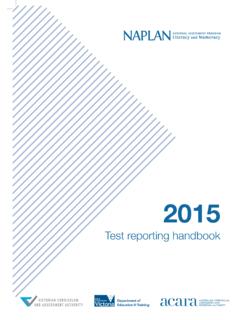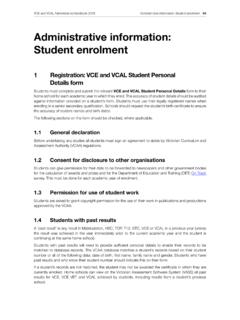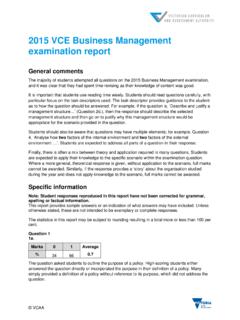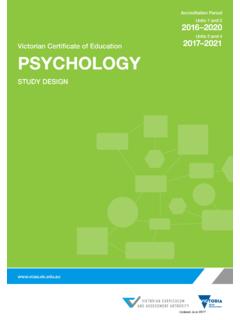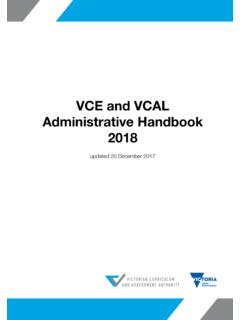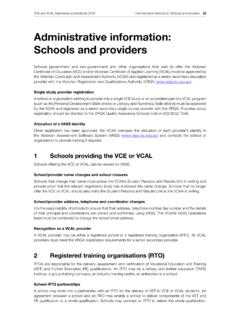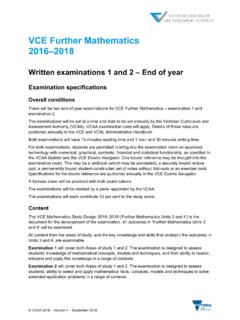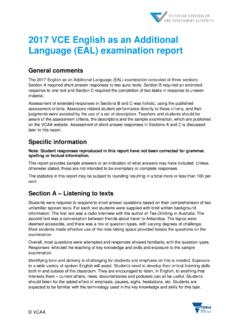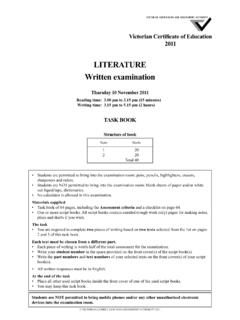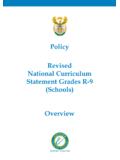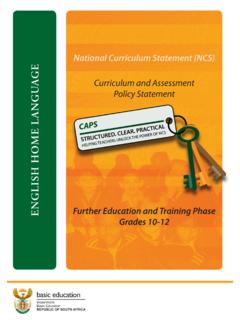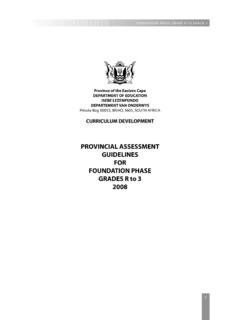Transcription of Victorian Curriculum F 10
1 Victorian Curriculum F 10 Revised Curriculum planning and reporting guidelines December 2015 Victorian Curriculum F 10: Revised Curriculum planning and reporting guidelines Authorised and published by the Victorian Curriculum and Assessment Authority Level 1, 2 Lonsdale Street Melbourne VIC 3000 December 2015 ISBN: 978-1-925264-27-2 Victorian Curriculum and Assessment Authority 2015 No part of this publication may be reproduced except as specified under the Copyright Act 1968 or by permission from the VCAA. For more information go to: The VCAA provides the only official, up-to-date versions of VCAA publications. Details of updates can be found on the VCAA website: This publication may contain copyright material belonging to a third party. Every effort has been made to contact all copyright owners. If you believe that material in this publication is an infringement of your copyright, please email the Copyright Officer: Copyright in materials appearing at any sites linked to this document rests with the copyright owner/s of those materials, subject to the Copyright Act.
2 The VCAA recommends you refer to copyright statements at linked sites before using such materials. The VCAA logo is a registered trademark of the Victorian Curriculum and Assessment Authority. This document is also available on the following website: Victorian Curriculum and Assessment Authority at Contents Summary .. 1 Introduction .. 3 Section 1: Curriculum Design .. 6 Context .. 6 Curriculum Planning guidelines .. 18 Foundation Stage (Prep Year 2) .. 19 Breadth Stage (Years 3 8) .. 20 Pathways Stage (Years 9 10).. 21 Section 2: Reporting Student Achievement .. 23 Context .. 23 Reporting guidelines .. 30 VCAA Page 1 Victorian Curriculum F 10: Revised Curriculum planning and reporting guidelines Summary These guidelines provide advice for Victorian schools on the development of whole-school Curriculum plans and reporting student learning achievement based on the Victorian Curriculum F 10. Specific sectoral requirements related to Curriculum provision and reporting are the responsibility of and published by the relevant sectoral authorities.
3 The school Curriculum is a statement of the purpose of schooling. It defines what it is that all students have the opportunity to learn as a result of their schooling, set out as a series of learning progressions. Enabling students progress along this learning continuum is the fundamental role of teachers and schools. The content of the Victorian Curriculum F 10 includes both knowledge and skills. These are defined by learning areas and capabilities. This Curriculum design assumes that knowledge and skills are transferrable across learning areas and capabilities. The capabilities enable students to develop particular values, dispositions and self-efficacy to become successful learners, confident and creative individuals and active and informed citizens .1 There is a distinction between the Curriculum and a school s teaching and learning program. The Curriculum is the common set of knowledge and skills that are required by all students for life-long learning, social development and active and informed citizenship.
4 As such, the Curriculum is the foundation of schools teaching and learning programs which are the school-based plans for delivering, expanding and extending this common set of knowledge and skills in ways that best utilise local resources, expertise and contexts. Schools have considerable flexibility in the design of their teaching and learning program. This enables schools to develop particular specialisations and areas of expertise and innovation while ensuring the Curriculum is delivered. The Victorian Curriculum F 10 has been designed on the assumption that it is a statement of the common set of learning, not the whole-school teaching and learning program for every school. This is to ensure there is time for schools to include in their teaching and learning program areas that reflect school or systemic priorities and for students to pursue specific interests and develop particular expertise. These guidelines set out an approach to Curriculum planning and provision structured by broad stages of schooling.
5 At the Foundation stage (Prep Year 2), schools focus on five Curriculum areas: English, Mathematics, The Arts, Health and Physical Education and Personal and Social Capability. 1 Ministerial Council on Education, Employment, Training and Youth Affairs 2008, Melbourne Declaration on Educational Goals for Young Australians, Melbourne. (accessed 7 December 2015). VCAA Page 2 Schools then broaden their focus and ensure that in each two-year band of schooling at the Breadth stage (Years 3 8) student learning includes each of the Curriculum areas, with a focus on English, Mathematics and Science. In the Pathways stage (Years 9 10), schools ensure students both receive a broad education and begin to plan their senior secondary program of study, which they can commence in Year 10. There is not a centrally prescribed single template for reporting student achievement to parents. Schools will be expected to report student achievement to parents every year in English, Mathematics and Science (from Year 3 onwards) against the achievement standards set out in the Victorian Curriculum F 10, including an indication of student progress against the age-related expected level of achievement.
6 For the other learning areas and capabilities, schools should report against the Victorian Curriculum F 10 achievement standards and in relation to what has been taught in a particular semester or year and to individual learning targets. In reporting student learning progress to parents, teachers and schools should clearly identify the areas of strength and areas for improvement for each individual student. Reports to parents should not rely on generic pre-populated comments often available in commercial reporting software packages. The school s teaching and learning program reflects the vision, direction and purpose of each individual school as determined by the engagement of teachers, students, parents and the local community. For this reason, schools should publish their own teaching and learning program as part of the information they provide to current and prospective students and parents and to the local community. Key points The following are the key points set out in these guidelines .
7 (a) Defined Curriculum content is the basis for student learning. (b) Curriculum planning will be based on two-year bands of schooling rather than each year level. (c) Schools should develop and publish a whole-school Curriculum plan that documents their teaching and learning program. (d) Schools must report student learning against the achievement standards in the Curriculum . (e) Schools will be able to report student learning to students and parents in formats that best suit local school communities rather than through a single centrally prescribed format. VCAA Page 3 Introduction 1. The Curriculum is a statement of the purpose of schooling. 2. The Curriculum defines what it is that all students have the opportunity to learn as a result of their schooling. According to Marzano, the provision of a guaranteed and viable Curriculum is one of the factors that has most impact on student learning2. 3. A high-quality Curriculum is not a collection of disconnected items of knowledge but rather a set of progressions that define increasingly complex knowledge, skills and concepts grouped and defined by learning areas and capabilities.
8 4. This identification of the purpose of schooling through the definition of what is to be taught and learnt provides a necessary framework for decisions about the structure of the teaching and learning program at each level of whole school, Curriculum area, individual year level and units of work. 5. It unclutters the Curriculum by making clear what is most important for all students to learn. 6. It enables teachers to identify the point of learning progression of each individual student and to plan for the appropriate next steps in learning. 7. Subsequent decisions about how this progress of student learning is reported to students themselves, to parents and carers, and to sectoral authorities are critical. This reporting provides the means to identify where and what kinds of interventions are necessary to support student learning. 8. Engaging in this learning process is the responsibility of students. 9. Enabling students learning progress is the role of teachers and schools.
9 It is enabled through effective pedagogy, assessment and reporting, as illustrated here. 10. In this representation, student learning is produced, shaped and affected by four connected components. Each of these components plays a separate and distinct role in the process of student learning and each is interconnected with all of the others. 11. The first is the Curriculum that defines what it is that students should learn, and the associated progression or continuum of learning. 12. The second is pedagogy that describes how students will be taught and supported to learn. 2 Marzano, R 2003, What Works in Schools: Translating Research into Action, Association for Supervision and Curriculum Development, Alexandria, VA. Student learning Curriculum (what) Pedagogy (how) Assessment (how well) Reporting (where) VCAA Page 4 13. The third is assessment that identifies how well a student has (or has not) learnt specified content.
10 14. The fourth is reporting that explains to the student and the teacher where a student is on a learning continuum at the end of a specified period of schooling, and where this places them in relation to their own learning goals and/or the learning of their peers. 15. These guidelines focus on the first and fourth components, Curriculum and reporting. 16. The school Curriculum is the subject of considerable public debate. 17. Some argue that any attempt to mandate content in the contemporary school Curriculum is immediately out-of-date. It is argued that the definition of Curriculum content (declarative knowledge) is a dated concept, rendered obsolete by the now-ubiquitous access provided by digital technologies to information. The only Curriculum appropriate for such an age, it is argued, is one based on defining the skills of information gathering, synthesising and evaluating; problem-solving; team work; creativity and innovation (procedural knowledge).
